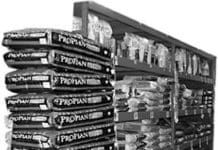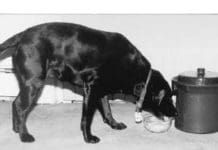Whole Dog Journal’s 2000 Canned Dog Food Review
these days?) and they can't share the information with you for fear that the knowledge will spread and this will result in some sort of advantage by their competitors.
The truth is
Labeling Dog Food Just Like People Food!
We’ve been whining lately about the dog food industry’s reluctance to embrace and use a “date of manufacture” on their product labels. There is no argument that fresher foods are better foods; with time, vitamins degrade, oils go stale and become rancid, and molds may develop, no matter what sort of preservatives are used. But the big pet food makers would rather concentrate on making their foods last as long as possible – extending shelf life with preservatives, keeping oxygen out of the food with cutting-edge technology bags, etc. – than working out a distribution system that gets their products into the bowls of consumers faster.
Who’s in Charge of Pet Food Manufacturing Regulations?
While most dog owners are certain that “someone” is in charge of regulating the manufacture of commercial dog food in this country, very few people know who that mysterious official or agency might be. But somebody’s gotta be making sure that dog food doesn’t contain any harmful ingredients and does contain what dogs need to survive, right? The FDA? Department of Agriculture? Someone?
Does Your Dog Eat Grass?
radish sprouts
Just Because Your Dog Has a Favorite Food Doesn’t Make It Nutritious!
There are hundreds of brands and flavors of dog food out there. You can find them everywhere, from the corner convenience store to the members-only warehouse center to the hard-to-find health food store for pets. And by golly, you’ve tried what seems like all of them! Yet you’re still not sure which are the best ones for your dog. On the other hand, your dog seems to have a definite opinion about it, and really prefers one of the less expensive grocery store brands. That’s great, you think, he loves the food and he’s saving me money! But is he? Is your dog’s preference for a particular food a good indication of the quality of the food?
Frozen Raw Meat Diets for Dogs
About frozen raw meat diets for dogs: We’ve got some good news, and some bad news. Here’s the good news: raw meat-based diets are really “what’s best” for dogs. With their sharp, tearing teeth, jaws capable of crushing bones, and short, highly acidic digestive systems, dogs are made to eat and thrive on diets that are made mostly of meat and bones. Every holistic veterinarian we know suggests feeding a raw meat-based diet, both to improve a dog’s existing health, or to recover it. Vital amino acids and food enzymes, vital for superior digestion and nutrient absorption, are present in raw meat, and survive the freezing/defrosting process beautifully.
Whole Dog Journal’s 2000 Dry Dog Food Review
The choices you make in selecting which dog foods to feed your pooch are probably more important than any others in terms of your influence on your dog’s health, no question about it. And yet, trying to get some straight information about how one can identify and select a high-quality, healthful dog food is like trying to get the president of the United States to admit he’s done something wrong: you’ll hear lies and innuendo, you’ll be led down false trails, you’ll hear conflicting information.
Raw-Fed Puppies
When dog lovers switch their pets from commercial food to a well-balanced, raw diet, they typically report improved health, brighter eyes, a shinier coat, calmer behavior, and easier yard cleanup chores. A puppy's first eight weeks set the stage for a lifetime of health or illness, so it isn't surprising that puppies weaned on raw food grow up to out-perform dogs weaned on kibble or canned food, even if both are fed raw food as adults. Raw-weaned puppies nearly exhaust their breeders' vocabularies, for these are the healthiest / strongest / liveliest / calmest / smartest / most wonderful pups that ever lived.
Canned Dog Food or Dry Dog Food? We’ll Help Break it Down
Caring guardians of companion canines often wonder whether one form of commercially prepared food – kibble or canned – is better than the other. The truth is, both types of food have relative advantages and disadvantages in terms of palatability, digestibility, and necessity for preservatives or other chemical additives. While they generally meet the same chemical composition standards in terms of vitamins, minerals, and amino acids, these types of food provide very different nutritional value.
Whole Dog Journal’s 2001 Dry Dog Food Review
and activity level? Is she a fast young Greyhound whose skinny frame carries no fat whatsoever? She'll probably need a higher-fat
Preserve Us!
energy value
It’s All In How You Make It
reduce pesticide residues by washing well

















